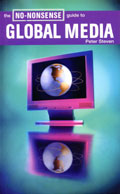

|
|

The No-Nonsense Guide to Global Media
Steven, Peter
Publisher: New Internationalist Publications/Between the Lines, Toronto, CanadaYear Published: 2004 Pages: 144pp Price: $14.95 ISBN: 1896357873 Library of Congress Number: P90.S75 2004 Dewey: 302.23 Resource Type: Book Cx Number: CX6692 Peter Steven aims to make readers realize the power and influence of dominant media but, at the same time, also understand that they are not "omnipotent" and that there are alternative forms available. Abstract: The No-Nonsense Guides are a series of books dealing with common topics of concern which most people care about but, find difficult to accurately research either due to a shortage of information or an excess of it. These include issues such as climate change, democracy, world history, sexual diversity and terrorism. The No-Nonsense Guide to Global Media tries to deal with multiple aspects of modern media including their effects on society, their history, the technology involved in producing and transmitting data, the influence of political and economic forces on media, the dangers of not understanding media's power and limitations and ways to work towards "a better media world." Peter Steven aims to make readers realize the power and influence of dominant media but, at the same time, also understand that they are not "omnipotent" and that there are alternative forms available. He talks about how different cultures interpret media programs differently and how, though many forms of media are globalized and shared by multiple cultures around the world, many forms are localized and very diverse. The author also discusses how both direct and indirect political and economic factors influence media which in turn affect culture over time. He describes media as a reflection of society, as well being an influence on it, and gives an overview of why and how "we watch, listen, read and surf." The book contains a chapter on the technological aspect of media and discusses how non-technological conditions affect the advancement of technology and vice versa. It briefly explains some technical media-related terms like "broadband," "satellite," and "compression technology." The book is short, interesting, informative and relevant to multiple fields of study. It contains maps, tables and charts to supplement the textual information provided and, also has multiple focus boxes within the text which provide interesting snippets of information from around the globe. [Abstract by Nabeeha Chaudhary] Contents: Foreword by Christine Morris Introduction Living with the media - voices from around the world Global media The howling, brawling, global marketplace - political economy The rise of the machines - technology Art and audience Media and society For a better media world Bibliography Contacts Index Subject Headings
|